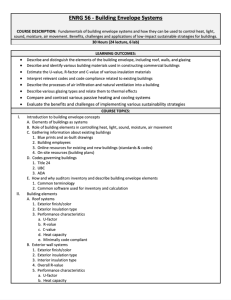ENRG 56: Building Envelope Systems

This 5-page outline provides information about the ENRG 56: Building Envelope Systems course that's part of the Commercial Building Energy Analysis and Audits program at City College of San Fancisco. This program is intended to prepare students to conduct energy audits, evaluate building systems for efficiency, analyze energy data, and apply financial and business strategies in audit reporting.
This course covers the "fundamentals of building envelope systems and how they can be used to control heat, light, sound, moisture, air movement." The "benefits, challenges and applications of low-impact sustainable strategies for buildings" is also covered. This outline includes a course description, learning outcomes, course topics, types of assignments, and textbooks and resources needed. Course topics include an introduction to building envelope concepts, codes governing buildings, building elements, exterior wall systems, ground floor systems, fenestration, interior construction, skylights, natural ventilation and more.
After completing the course, students should be able to:
- Describe and distinguish the elements of the building envelope, including roof, walls, and glazing.
- Describe and identify various building materials used in constructing commercial buildings.
- Estimate the U-value, R-factor and C-value of various insulation materials.
- Interpret relevant codes and code compliance related to existing buildings.
- Describe the processes of air infiltration and natural ventilation into a building.
- Describe various glazing types and relate them to thermal effects.
- Compare and contrast various passive heating and cooling systems.
- Evaluate the benefits and challenges of implementing various sustainability strategies.
About this Resource


Comments